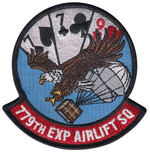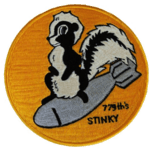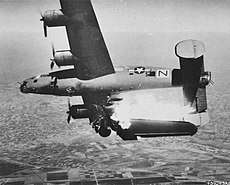779th Expeditionary Airlift Squadron
The 779th Expeditionary Airlift Squadron is a provisional United States Air Force unit. Its most recent activation was in 2018 for Operation Inherent Resolve. It has also been activated for contingency operations at Ramstein Air Base.
| 779th Expeditionary Airlift Squadron | |
|---|---|
 C-130 Hercules in 1960s camouflage | |
| Active | 1943-1945; 1953-1957; 1963–1971, 2006, 2008, c. 2018 |
| Country | |
| Branch | |
| Role | Airlift |
| Engagements | Mediterranean Theater of Operations Vietnam War |
| Decorations | Distinguished Unit Citation Air Force Outstanding Unit Award with Combat "V" Device Republic of Vietnam Gallantry Cross with Palm |
| Insignia | |
| Patch with 779th Expeditionary Airlift Squadron emblem |  |
| Patch with 779th Troop Carrier Squadron emblem |  |
| 779th Bombardment Squadron emblem[1] |  |
| Tail Code after 1968 | PR |
The squadron was first active during World War II as the 779th Bombardment Squadron. After training in the United State, the squadron flew Consolidated B-24 Liberators in the Mediterranean Theater of Operations in the strategic bombing campaign against Germany. It earned two Distinguished Unit Citations for its actions during this campaign. Following the war, the squadron served in Air Transport Command to transport troops back to the United States from a base in South America before inactivating.
In June 1955, the squadron was reactivated as the 779th Troop Carrier Squadron at Pope Air Force Base, North Carolina, when the 464th Troop Carrier Group expanded from three to four operational squadrons. It was inactivated in 1957, but activated again in 1965 as the 464th Troop Carrier Wing was converting from the Fairchild C-123 Provider to the Lockheed C-130 Hercules. It was inactivated on 31 August 1971, when the 41st Tactical Airlift Squadron replaced it at Pope.
History
World War II
![]()

The 779th Bombardment Squadron was activated on 1 August 1943 at Wendover Field, Utah as a Consolidated B-24 Liberator heavy bombardment unit. The squadron was one of the 464th Bombardment Group's four original squadrons,[2][2][3][4][5] After gathering its initial cadre, the squadron moved to Gowen Field, Idaho for training with II Bomber Command. After training in Idaho and Utah, the squadron began its move to the Mediterranean Theater of Operations in February 1944.[6]
The 779th deployed to southern Italy in February 1944, where it became part of Fifteenth Air Force's 55th Bombardment Wing. The air echelon trained for a few weeks in Tunisia before joining the remainder of the group in Italy and entering combat in April.[6]
The group engaged in long range strategic bombing missions to enemy military, industrial and transportation targets in Italy, France, Germany, Austria, Hungary, Romania, and Yugoslavia, bombing railroad marshaling yards, oil refineries, airdrome installations, heavy industry, and other strategic objectives.[6]
Notable missions of the Oil Campaign of World War II included Operation Tidal Wave, bombing of the Concordia Vega Refinery near Ploiești on 18 May 1944, the marshaling yards and oil refinery at Vienna on 8 July 1944, for which the squadron was awarded the Distinguished Unit Citation, and the Pardubice oil refinery and nearby railroad tracks on 24 August 1944, for which it also was awarded a Distinguished Unit Citation.[7]
The squadron sometimes engaged in support and interdiction operations. It supported Allied forces during Operation Dragoon, the invasion of Southern France in August 1944. It hit railroad centers to assist the advance of the Red Army in southeastern Europe in March 1945. It bombed enemy supply lines to assist Operation Grapeshot, the advance of the US Fifth and British Eighth Army in northern Italy in April 1945.[6]
After V-E Day, the squadron was assigned to the Green Project, the movement of troops from Europe to the United States via the South Atlantic Transport Route. B-24s were modified with sealed bomb bays, removal of all defensive armament and internal fuselage equipped with seating to carry approximately 30 personnel. It was assigned to Air Transport Command at Waller Field, Trinidad. The group moved personnel from Natal, Brazil and Atkinson Field, British Guiana to Morrison Field, Florida. It provided air transport until the end of July when the unit was inactivated.[2][6]
C-119 Operations

The squadron was reactivated as the 779th Troop Carrier Squadron at Pope Air Force Base, North Carolina on 8 June 1955, when the 464th Troop Carrier Group expanded from three to four operational squadrons. It was equipped with Fairchild C-119 Flying Boxcars The unit provided tactical airlift of troops and cargo, participated in joint airborne training with Army forces, and took part in tactical exercises in the United States and overseas. The squadron provided aeromedical airlift and flew humanitarian missions as required until inactivating in August 1957.[2][8]
C-130 operations
The squadron was reactivated at Pope on 1 July 1963 as the 464th Troop Carrier Wing began to convert its other squadrons to the Lockheed C-130 Hercules aircraft[8] and equipped with Fairchild C-123 Providers from the wing's other squadrons.
In 1965 the squadron received twelve modified C-130E-(I)s for special operations use and began training with the new airplanes in early 1966. The C-130E-(I)s were assigned to Detachment 1, 779th Troop Carrier Squadron. The squadron was placed on alert shortly after the USS Pueblo was captured by North Korea in January 1968. They were deployed to Tachikawa Air Base, Japan shortly thereafter. After a few days at Tachikawa they deployed to Cam Ranh Bay Air Base, Vietnam where they flew supply and troop transport during the Tet Offensive. While at Cam Ranh, enemy rockets were fired at the base from the overlooking hills striking fuel drums and a fuel bladder but no damage was don to the C-130s parked nearby. In early April 1968 they returned to Pope and were replaced in Cam Ranh Bay by the 778th Tactical Airlift Squadron also from Pope AFB, NC. The detachment was replaced by the 318th Special Operations Squadron in the late 1960s.
In August 1971, the squadron was inactivated and its mission, personnel and equipment were transferred to the 41st Tactical Airlift Squadron, which was activated at Pope the same day.[9][10]
Expeditionary operations
The squadron was converted to provisional status as the 779th Expeditionary Airlift Squadron. It was activated at Ramstein Air Base, Germany, and inactivated on 15 April 2006.[11]
Lineage
- Constituted as the 779th Bombardment Squadron (Heavy) on 19 May 1943
- Activated on 1 August 1943
- Redesignated 779th Bombardment Squadron, Heavy on 29 September 1944
- Inactivated on 31 July 1945
- Redesignated 779th Bombardment Squadron, Very Heavy on 14 November 1945 (Remained inactive)
- Redesignated 779th Troop Carrier Squadron, Medium on 15 December 1952
- Activated on 8 June 1955
- Inactivated on 1 August 1957[12]
- Redesignated 779th Troop Carrier Squadron, Assault and activated on 12 June 1963 (not organized)[13]
- Organized on 1 July 1963[9]
- Redesignated 779th Troop Carrier Squadron on 1 March 1966
- Redesignated 779th Tactical Airlift Squadron on 1 May 1967
- Inactivated on 31 August 1971[9]
- Redesignated 779th Expeditionary Airlift Squadron and converted to provisional status c. 3 May 2002
- Activated unknown date
- Inactivated 15 April 2006[11]
Assignments
- 464th Bombardment Group, 1 August 1943 – 31 July 1945
- 464th Troop Carrier Group, 1 February 1953 – 1 August 1957[12]
- 464th Troop Carrier Wing (later 464th Tactical Airlift Wing), 1 July 1963 – 31 August 1971 (attached to 315th Air Division 7 February 1968 - 31 March 1968)[8][12][14]
- Air Mobility Command to activate or inactivate as needed c. 3 May 2002
- 721st Air Mobility Operations Group, unknown – 15 April 2006[11]
Stations
|
|
Aircraft
- Consolidated B-24 Liberator, 1943–1945
- Fairchild C-119 Flying Boxcar, 1953–1958
- Fairchild C-123 Provider 1963-1966
- Lockheed C-130 Hercules, 1966–1971
Awards and Campaigns
| Award streamer | Award | Dates | Notes |
|---|---|---|---|
| Distinguished Unit Citation | 8 July 1944 | Vienna, Austria, 779th Bombardment Squadron[2] | |
| Distinguished Unit Citation | 24 August 1944 | Pardubice, Czechoslovakia, 779th Bombardment Squadron[2] | |
| Air Force Outstanding Unit Award with Combat "V" Device | 1 July 1967-10 April 1968 | 779th Tactical Airlift Squadron[16] | |
| Republic of Vietnam Gallantry Cross with Palm | 1 July 1967-10 April 1968 | 779th Tactical Airlift Squadron[16] |
| Campaign Streamer | Campaign | Dates | Notes |
|---|---|---|---|
| Rome-Arno | 10 April 1944 – 9 September 1944 | 779th Bombardment Squadron[2] | |
| Southern France | 15 August 1944 – 14 September 1944 | 779th Bombardment Squadron[2] | |
| Northern France | 25 July 1944 – 14 September 1944 | 779th Bombardment Squadron[2] | |
| North Apennines | 10 September 1944 – 4 April 1945 | 779th Bombardment Squadron[2] | |
| Po Valley | 3 April 1945 – 8 May 1945 | 779th Bombardment Squadron[2] | |
| Vietnam Air/Ground | 22 January 1968–7 July 1968 | 779th Tactical Airlift Squadron[17] | |
| Vietnam Air Offensive, Phase III | 1 April 1968–31 October 1968 | 779th Tactical Airlift Squadron[17] | |
| Vietnam Air Offensive, Phase IV | 1 November 1968–22 February 1969 | 779th Tactical Airlift Squadron[17] |
References
Notes
- Watkins, pp.112-113
- Maurer, Combat Squadrons, p. 752
- Maurer, Combat Squadrons, pp. 750-751
- Maurer, Combat Squadrons, p. 751
- Maurer, Combat Squadrons, pp. 749-750
- Maurer, Combat Units, pp. 339-340
- "Our Missions: The 464th BG Mission List". The 464th Bombardment Group (H). zplace2b.com. Archived from the original on 24 March 2009. Retrieved 20 March 2009.
- Ravenstein, pp. 258-260
- See Mueller, p. 485 (showing dates squadrons were at Pope).
- Dollman, TSG David (October 18, 2016). "Factsheet 41 Airlift Squadron (USAFE)". Air Force Historical Research Agency. Retrieved January 6, 2018.
- Research Division, Air Force Historical Research Agency, Air Force Organization Change Status Report, April 2006, Maxwell AFB, AL
- Lineage, including assignments and stations, through March 1963 in Maurer, Combat Squadrons, p. 752
- AFOMO Letter 61n, 13 June 1963, Subject: Activation of Headquarters, 839th Air Division and Certain Other USAF Unit Actions
- "Factsheet 315 Air Division". Air Force Historical Research Agency. 12 October 2007. Archived from the original on October 30, 2012. Retrieved February 24, 2014.
- Mueller, p. 485
- "Air Force Personnel Services: Unit Awards". Air Force Personnel Center. Retrieved July 10, 2019. (search)
- AF Pamphlet 900-2, p. 458
Bibliography
![]()
- Maurer, Maurer, ed. (1983) [1961]. Air Force Combat Units of World War II (PDF) (reprint ed.). Washington, DC: Office of Air Force History. ISBN 0-912799-02-1. LCCN 61060979. Retrieved December 17, 2016.
- Maurer, Maurer, ed. (1982) [1969]. Combat Squadrons of the Air Force, World War II (PDF) (reprint ed.). Washington, DC: Office of Air Force History. ISBN 0-405-12194-6. LCCN 70605402. OCLC 72556. Retrieved December 17, 2016.
- Mueller, Robert (1989). Air Force Bases, Vol. I, Active Air Force Bases Within the United States of America on 17 September 1982 (PDF). Washington, DC: Office of Air Force History. ISBN 0-912799-53-6. Retrieved December 17, 2016.
- Ravenstein, Charles A. (1984). Air Force Combat Wings, Lineage & Honors Histories 1947-1977. Washington, DC: Office of Air Force History. ISBN 0-912799-12-9. Retrieved December 17, 2016.
- Watkins, Robert A. (2009). Insignia and Aircraft Markings of the U.S. Army Air Force In World War II. Volume IV, European-African-Middle Eastern Theater of Operations. Atglen,PA: Shiffer Publishing, Ltd. ISBN 978-0-7643-3401-6.
- "AF Pamphlet 900-2, Unit Decorations, Awards and Campaign Participation Credits" (PDF). Washington, DC: Department of the Air Force. 15 June 1971. Retrieved August 11, 2016.